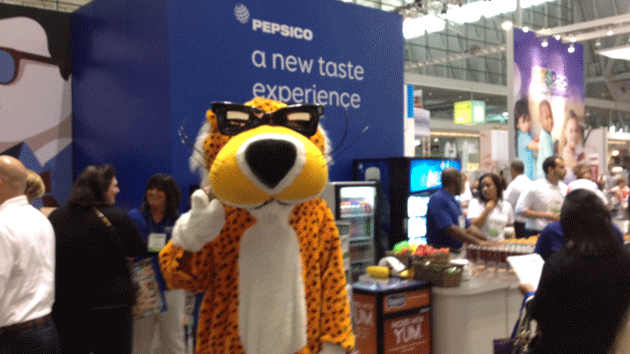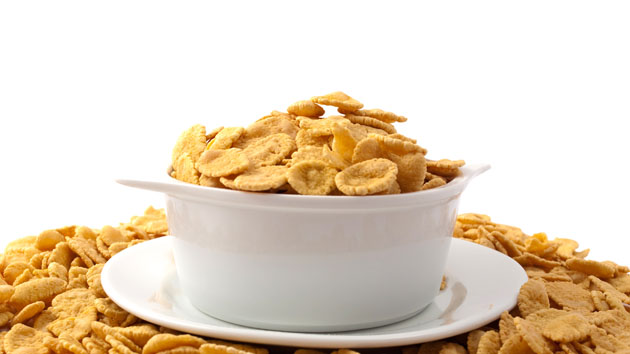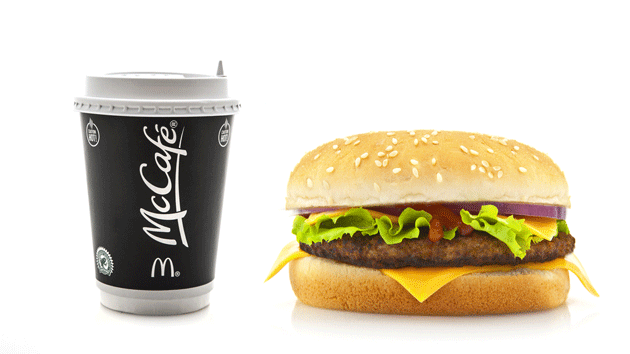
Chester the Cheetah hung out near the booth owned by PepsiCo, maker of Cheetos. Photo by Kiera Butler
At exactly 10 a.m. on Monday, hundreds of school cafeteria professionals ran hooting and clapping down an escalator into an exhibition hall that looked like a cross between a mall food court and the set of Barney. Pharrell blared over loudspeakers. The Pillsbury Doughboy was on hand for photo ops, as was Chester the Cheetah (the Cheetos mascot) and a dancing corn dog on a stick. Attendees queued up to be contestants in a quiz show called “Do You Eat Smarter Than a Fifth-Grader?” and flocked toward trays groaning with every kind of kid food one could imagine: tater tots, PB&Js with crusts preremoved, toaster waffles with built-in syrup, and endless variations on the theme of breaded poultry: chicken tenders, chicken bites, chicken rings, chicken patties, and, of course, chicken nuggets.
I was at the annual conference of the School Nutrition Association (SNA), the professional group that represents the nation’s 55,000 school food workers, and the biggest draw of the event—the exhibition hall—had just opened for business. More than 400 vendors vied for the attention of the conference’s 6,500 attendees, who had descended on the Boston Convention and Exhibition Center with one main goal: to find new foods to serve at their schools.
Many of the vendors were household names: Sara Lee, Kraft, Perdue, Uno, and Pizza Hut, to name a few. Among the corporate sponsors who collectively put up about $200,000 to help stage the affair were Domino’s Pizza, PepsiCo, Tyson, General Mills, and AdvancePierre Foods, which bills itself as “the No. 1 provider of fully-cooked protein and assembled sandwiches to school systems across the country.”

To be sure, you won’t find most of the items on exhibit in supermarkets or restaurants. That’s because they are specially made to conform to the new federal school nutrition standards, some of which took effect July 1. There are fruit and vegetable requirements; limits on calories, sodium, and saturated fats; and a mandate that all grain foods served at school must be at least 51 percent whole grain.* The rules—which I’ll cover in more detail in a subsequent post—are contentious, and the SNA opposes some of them. Politico‘s Helena Bottemiller Evich reported that after first lady Michelle Obama spoke out in favor of the rules, organizers told the White House that its senior adviser for nutrition policy, Sam Kass, would not be allowed to speak at the conference.
Politics aside, the vendors were armed with newly formulated products designed to conform to the rules. At the Kraft booth, a rep gushed about the virtues of the company’s new flavored cream cheeses, available in milk chocolate, dark chocolate, and caramel, “with half the calories of Nutella.” She told me they were designed as dips for fruits with the new produce rule in mind. “Nowadays, it’s the only way to get kids to eat anything that’s good for them,” she said.

Indeed, the exhibitors’ guiding principle seemed to be something like: “Whatever you do, don’t tell them it’s healthy.” I watched as a Sara Lee rep promised a cafeteria director from Louisiana that her students wouldn’t be able to detect the whole-grain flour in her company’s chocolate muffin. The PepsiCo booth stocked a flyer (below) informing attendees that newly formulated Cheetos fit with the guidelines. When I sampled a vitamin-fortified, low-cal Slush Puppy, the rep asked me, “Doesn’t that taste just as good as a regular slushy?” (It didn’t.) A food service company rep promised me that his funnel cake was “plenty sweet,” even though it fit within the calorie limits. (It was.)

While the exhibitors were eager to show off their products’ nutritional stats, few offered actual ingredients lists. When I asked the rep at the Uno pizza booth why ingredients weren’t included on his nutrition information sheet, he told me the list wouldn’t fit on the page.
“Don’t the school nutritionists ask you what’s in this?” I asked. Nope, he said. Most of them just wanted to know whether the product met the legal guidelines. He offered to email me the list later. When he did, I learned that Uno’s Whole Grain Low Sodium Sweet Potato Crust Pepperoni Pizza contained nearly 50 ingredients, including sodium nitrite, which has been linked to cancer. I also persuaded the Domino’s rep to email me a list of ingredients in his company’s specially formulated school pizza, SmartSlice. It was also nearly 50 items long, and included silicone dioxide, otherwise known as sand.
After wandering through most of the 180,000 square feet of exhibits, I came across an earnest gray-haired woman in the back of the cavernous room selling frozen “pulses”—mostly lentils and chickpeas—to stir into soups and sauces. I was the only one at her booth. Had she noticed that everyone seemed drawn to the big-name foods up front? She responded that she hoped attendees would consider fortifying their name-brand meals with some of her lentils. “If you add a pulse product to a potato salad, it steps up the nutrition,” she offered hopefully.
But the attendees would have to find her first, and that would be a tall order: Corporations such as PepsiCo and General Mills had rented out multiple exhibit spaces ($2,400 to $2,600 a pop) in the high-traffic front and central aisles of the exhibit floor. Some big booths even had café-style seating areas where attendees chatted as they gobbled up samples. “You have to go in the far corners to find the more interesting stuff,” says Steve Marinelli, who runs the food program for a rural Vermont school district and told me he was having trouble locating the wholesome foods he wanted. “Someone was selling this really cool hummus, but you really had to look hard to find it.”
The lentil lady didn’t stand a chance.
Correction: The original version of this post stated that a new rule would raise the whole-grain requirement from 51 percent to 100 percent of a given food. The rule actually applies to all grain foods: The old rule required that half of grain foods served must be whole-grain rich (which is defined as 51 percent whole grain). Starting July 1, all grain foods served must be whole-grain rich. The post has been corrected.













